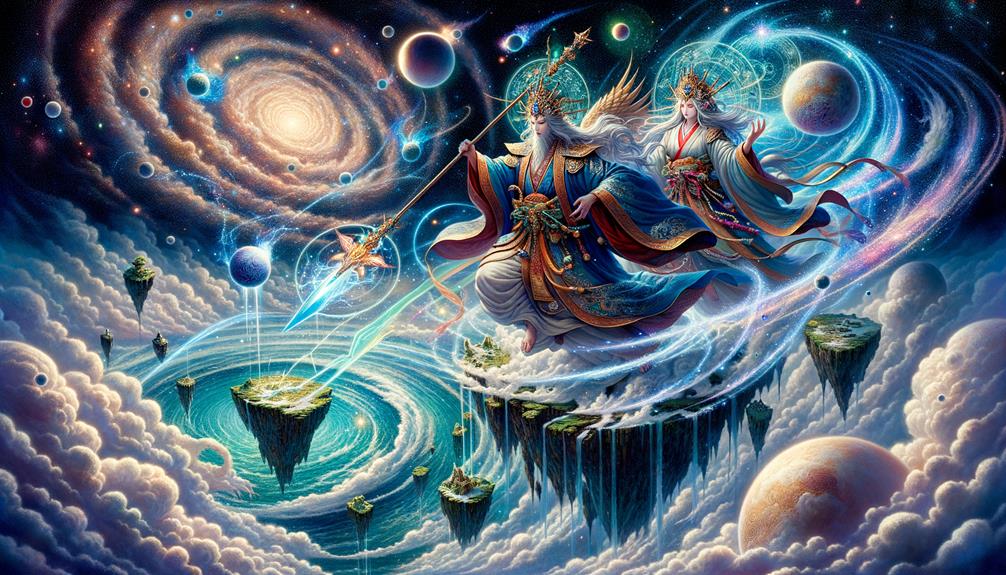Izanagi and Izanami's stirring of the ocean depths with a jeweled spear birthed the islands of Japan and a symbolic narrative. Their union and trials embody the primal struggle to create and life's transformative power through birth and rebirth. When Izanami descends to Yomi, and Izanagi ventures to retrieve her, we witness an archetypal hero's journey exploring loss, regeneration, and life's cycles. Their mythic odyssey unveils profound insights about creation's tribulations and the eternal dance between being and non-being.
The Birth of Izanagi and Izanami
Generations ago, two celestial beings named Izanagi and Izanami emerged as the first divine creators. With a jeweled spear, they shaped our world from its formless state. Their union and actions symbolize creation and birth in Japanese mythology.
Izanagi and Izanami descended to the unformed realm. By stirring the ocean depths with their spear, they initiated the world's emergence, bringing order from chaos. This creative act represents the mythical quest to forge something new from the unknown.
Initially, they faced challenges when their child Hiruko was born deformed. But after consulting heavenly deities, Izanami successfully birthed the islands of Awaji and Honshu, laying the foundations for Japanese myths.
Through perseverance, Izanagi and Izanami's tale explores timeless themes – the struggle to create, the transformative power of divine forces, and the potential for rebirth even after setbacks. Their narrative has endured as a captivating origin story.
The Creation of Japan
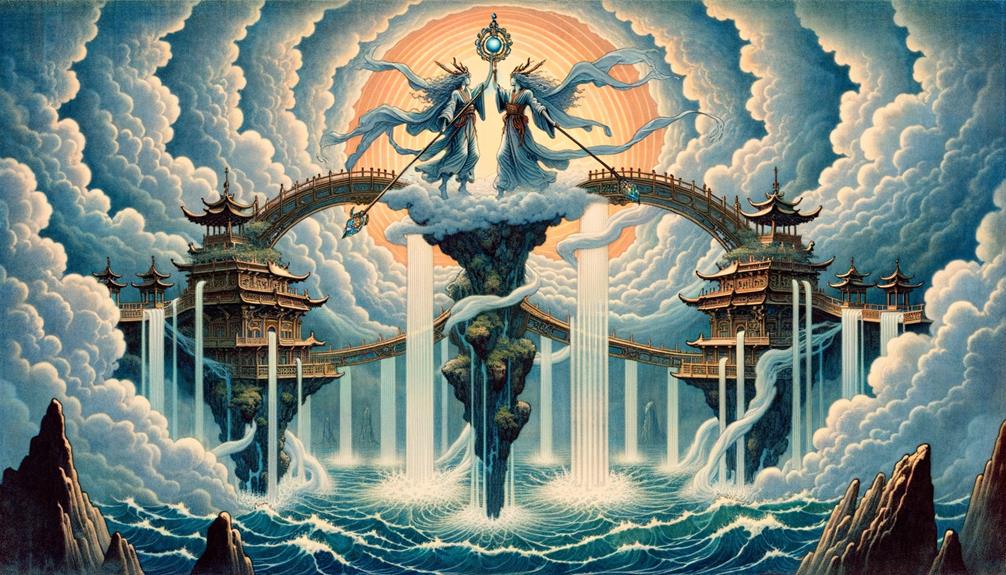
When Izanagi and Izanami stirred the primordial ocean with Ama no Nuboko, they initiated a sacred ritual that formed the Land of Eight Great Islands. Each island, from Awaji to Honshu, symbolizes more than mere geography; it represents the divine forces that birthed order and cultural identity in this ancient myth. This creation story transcends physical landscapes, embodying the union of celestial beings and the origins of Japan's cultural heritage.
Divine Union Rituals
Izanagi and Izanami's sacred union symbolized creation's origins, churning primordial chaos with the sacred jewelled spear Ama no Nuboko to birth Onogoro Island. As the divine couple descended from the heavens, their mission was clear: bring order to formless chaos. The jewelled spear, representing divine authority and creative power, played a pivotal role. Its droplets falling into primordial waters solidified into Onogoro, their first sacred creation.
This act formed more than land; it laid the foundation for Japan's creation myth. Their union birthed islands like Awaji, Shikoku, and Honshu, signifying their sacred bond. Through these rituals, Izanagi and Izanami shaped more than geography; they shaped Japanese culture and Shinto belief's essence.
Their transformative journey from chaos to creation mirrors the hero's journey archetype. The divine couple transformed the void into a structured world, imbuing the islands with spiritual significance and shaping Japan's very nature.
Sacred Islands Formation
Japan's sacred islands didn't just form through geographic processes – they represent the nation's cultural heart. Let's dive into their mythological roots.
The ancient gods Izanagi and Izanami stood on the Heavenly Bridge, dipping a jeweled spear into the ocean below. When they lifted it, droplets fell and hardened, birthing the first island – Awaji. This kicked off the formation of the entire archipelago, each island carrying deep significance:
Awaji represented life's spark. Shikoku embodied elemental harmony. Kyushu symbolized resilience and strength. Honshu formed Japan's cultural core. Though not originally part of the eight major islands, Okinawa later became integral too.
Through the divine couple's union, the heavens and earth intertwined, shaping Japan's geography and mythical foundations. This creation story set the stage for the country's rich heritage that endures today.
Mythological Offspring Significance
The birth of Amaterasu, Tsuki-yomi, and Susanoo from the divine couple's union signifies the formation of Japan's celestial hierarchy and the shaping of its mythological landscape. Izanagi and Izanami's offspring don't merely populate the pantheon; they symbolize the fundamental forces that shape life and culture. Amaterasu, the sun goddess, personifies light and order, while Tsuki-yomi, the moon god, represents the passage of time. Susanoo, the storm god, brings chaos but also renewal. Their creation marks the genesis of a structured cosmos from primordial chaos.
Within the hero's journey framework, these deities serve as archetypes that Japanese culture and Shintoism revolve around. Izanagi's descent into the underworld and his purification rituals upon return are critical mythological moments, leading to the birth of these significant offspring. This mythic narrative isn't just ancient history; it underpins the divine right of Japanese emperors, tracing their lineage back to these celestial beings.
The creation of these deities by Izanagi and Izanami signifies the intertwining of the sacred and the temporal, casting a divine light on the origins of Japan and its enduring cultural ethos. These myths are foundational, shaping not just belief but identity.
The Birth of the Kami
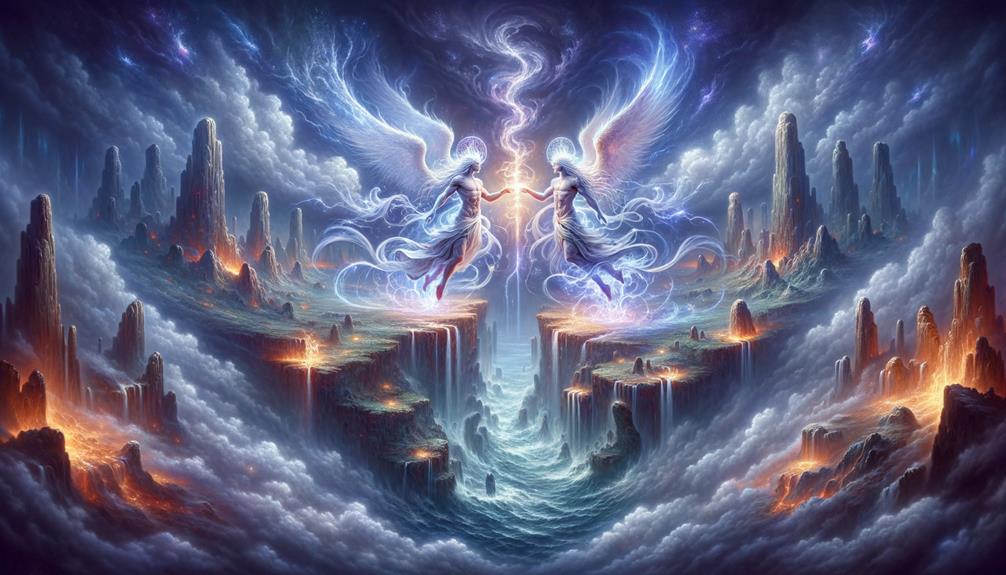
The union of the divine couple, Izanagi and Izanami, gave birth not just to physical islands but spiritual entities called Kami, infusing the essence of nature into existence. Their sacred act intertwined heaven and earth, the spiritual and physical realms. The emergence of Kami marked the presence of divinity across the Japanese archipelago, etching the sacred into every facet of nature.
This creative process transcended mere geography; it breathed life into the world. Each island, from Awaji to Honshu, carried the essence of the divine. The union resulted in:
- Amaterasu: The radiant Sun Goddess illuminating the heavens.
- Tsukuyomi: The Moon God embodying the night's enigma.
- Susanoo: The Storm God symbolizing nature's ferocity.
- Hiruko: Their unsatisfactory first child, representing an initial failure.
- Oyashimakumi: The Land of Eight Great Islands forming Japan's foundation.
These deities bridged realms beyond the physical, connecting heaven, earth, and the shadowy underworld, weaving a tapestry of myths that still resonates today.
The Death of Izanami
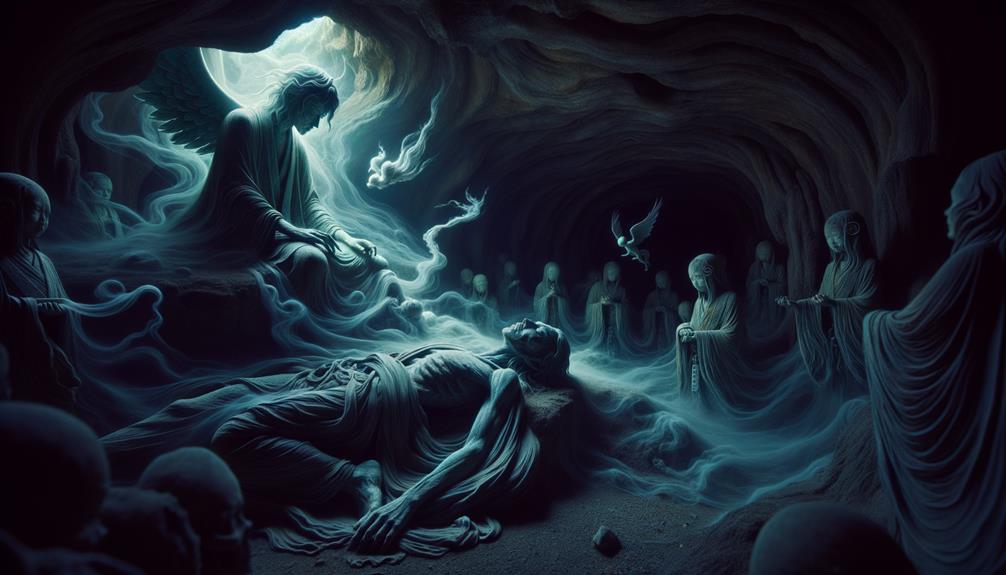
Izanami's tragic death from the flames of Kagutsuchi symbolized the cyclical nature of creation and destruction. Izanagi's journey into the underworld to retrieve her mirrored the archetypal hero's descent, only to confront mortality's harsh reality. This pivotal moment shattered their divine union, paving the way for Izanagi's purification and the birth of new deities – a profound shift in Japanese mythology.
Izanami's Tragic Demise
Izanami's ill-fated end emerges as she succumbs to burns from birthing the fire god Kagutsuchi, embodying the life-giver who transitions to the realm of the deceased. Her death transcends personal tragedy, signifying a cosmic separation between the living and the dead. Following her passing, Izanami descended into Yomi, the shadowy afterlife of Japanese myth, a place of decay.
In Yomi, Izanami's divine form withered, ravaged by death's touch. When Izanagi braved Yomi to retrieve her, he recoiled at her decomposed state, fleeing – symbolizing the finality of death's divide. Their encounter underscores decay's inevitability and death's irreversibility.
Izanami's demise marks a pivotal moment; her descent into Yomi introduces the afterlife's concept. Yomi's darkness becomes integral to her narrative as her death cleaves a profound rift between realms. Her sorrowful yet transformative end encapsulates the inescapable shift from life to death, forever altering cosmic order.
Impact on Izanagi
Izanagi's harrowing descent into Yomi and frantic escape from Izanami's decayed form signaled a profound shift, depicting the hero's inevitable confrontation with mortality and separation from the divine feminine. When Izanami perished after birthing Kagutsuchi, the fire god, her journey into Yomi, the underworld, marked a stark transition from creation to decay.
Encountering Izanami's corrupted body in Yomi, Izanagi reacted with horror and grief. This pivotal moment highlighted the hero's exposure to death's grotesque reality, a stark contrast to the vibrant life they once shared. As Izanagi fled the underworld, Izanami's relentless pursuit symbolized the inescapable grasp of death and the past.
The dramatic escape culminated in Izanagi sealing the entrance to Yomi, a powerful act severing the realms of the living and the dead. This act also marked the end of their divine union, establishing a boundary that would shape the cosmic order.
Izanagi's Journey to Yomi
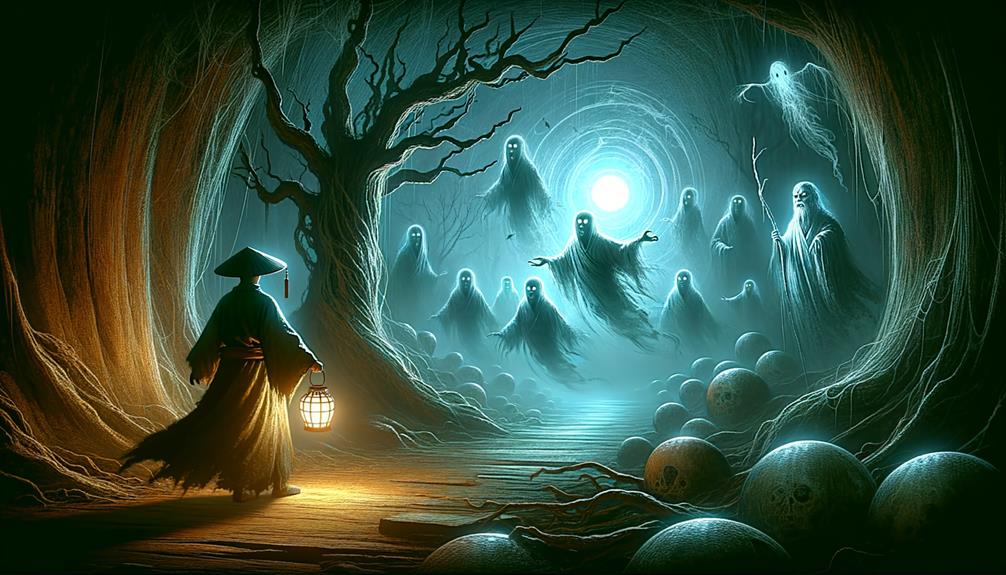
Izanagi's descent into Yomi, the realm of the dead, symbolizes a hero's confrontation with the unknown and mortality. His journey began with a heartbreaking quest to retrieve his beloved Izanami, who had passed away. This mythological exploration of the underworld carries profound meaning, reflecting a hero's struggle against death's inevitability and the pain of separation.
Izanagi's journey reveals several key aspects:
- Facing decay: Izanagi discovered Izanami's decaying, maggot-infested body, representing death's harsh reality.
- Realization and retreat: Confronted with Izanami's transformed state, Izanagi fled, highlighting the instinctual fear and rejection of death.
- Pursuit and escape: Izanami's pursuit of Izanagi as he fled Yomi underscores death's inescapable shadow.
- Sealing the divide: Izanagi's act of sealing the entrance to Yomi symbolizes the definitive separation between the living and the dead.
- Mythological themes: This journey underscores themes of love, loss, and the boundaries between life and death.
Izanagi's journey to Yomi is a powerful narrative encapsulating the hero's confrontation with death, underscoring the profound separation between the mortal and the eternal.
Themes in Japanese Mythology
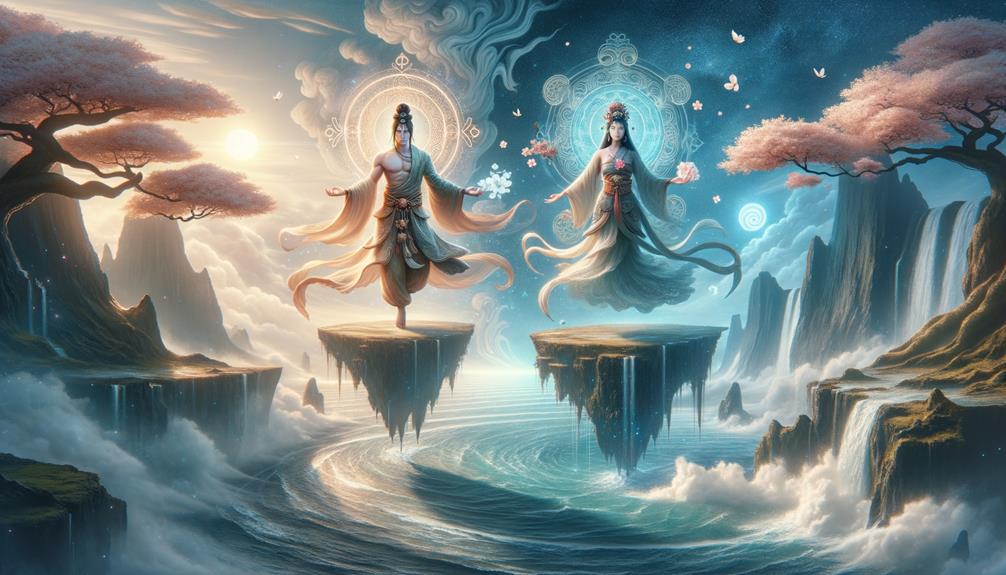
Japanese mythology's tales of Izanagi and Izanami unfold profound themes of creation, change, and life's delicate dance with death. Their stirring of the primordial sea with a celestial spear birthed the islands, order emerging from chaos. This seminal act sparked the arrival of countless deities, each a force of nature or human experience given form.
When Izanami tragically perishes after birthing the fire god, it represents creation's intertwined nature with destruction. Her demise underscores life's cycles, the inevitability of transformation. Izanagi's sojourn to the underworld Yomi and escape depict a hero's journey navigating loss and redemption while defining the realms of living and dead.
The sacred regalia bestowed upon Amaterasu – the mirror, jewels, and sword – symbolize light, stability, continuity; elements vital for harmony's preservation. The imperial genealogy tracing back to the primordial couple firmly roots this mythic narrative within Japanese cultural identity.
Frequently Asked Questions
Who Created Izanami and Izanagi?
In ancient Japanese mythology, Izanami and Izanagi, the divine couple responsible for creating the islands of Japan, emerged from the primordial void. Their story marks the beginning of the world's sacred formation.
How Do Izanagi and Izanami Create Land?
Here's a more conversational rewrite, avoiding the listed AI words:
Envision two divine beings stirring the ancient ocean, forming islands like lustrous pearls emerging from the depths. These archetypal creators embarked on an epic journey, sculpting our world and laying cultural foundations. Their actions resonate as a mythic quest, shaping lands and establishing societal bedrock.
What Job Are Izanami and Izanagi Given by the Gods?
Creation myths often depict deities tasking heroes with shaping the primordial cosmos. For the Japanese gods, this sacred duty fell upon Izanami and Izanagi. Their odyssey centered on transforming disorder into order, manifesting land from the ethereal abyss, and nurturing the birth of other divinities. This archetypal duo personified the eternal struggle towards structure and vitality.
What Are the Symbols of Izanami?
Izanami's mystique surrounds the Yomotsu-Hirasaka gateway to the afterlife and her feathered robe. Picture her adorned with magatama jewels, venerated through kagura dances, and honored by the tranquil melodies of the koto. Her presence radiates serenity and reverence for the sacred realm beyond our world.

